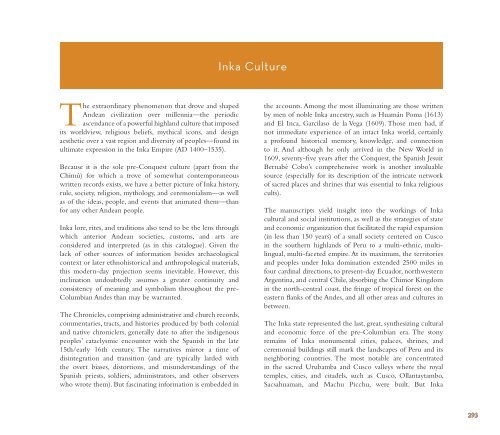You also want an ePaper? Increase the reach of your titles
YUMPU automatically turns print PDFs into web optimized ePapers that Google loves.
Inka Culture<br />
The extraordinary phenomenon that drove and shaped<br />
Andean civilization over millennia––<strong>the</strong> periodic<br />
ascendance of a powerful highland culture that imposed<br />
its worldview, religious beliefs, mythical icons, and design<br />
aes<strong>the</strong>tic over a vast region and diversity of peoples––found its<br />
ultimate expression in <strong>the</strong> Inka Empire (AD 1400–1535).<br />
Because it is <strong>the</strong> sole pre-Conquest culture (apart from <strong>the</strong><br />
Chimú) for which a trove of somewhat contemporaneous<br />
written records exists, we have a better picture of Inka history,<br />
rule, society, religion, mythology, and ceremonialism––as well<br />
as of <strong>the</strong> ideas, people, and events that animated <strong>the</strong>m––than<br />
for any o<strong>the</strong>r Andean people.<br />
Inka lore, rites, and traditions also tend to be <strong>the</strong> lens through<br />
which anterior Andean societies, customs, and arts are<br />
considered and interpreted (as in this catalogue). Given <strong>the</strong><br />
lack of o<strong>the</strong>r sources of information besides archaeological<br />
context or later ethnohistorical and anthropological materials,<br />
this modern-day projection seems inevitable. However, this<br />
inclination undoubtedly assumes a greater continuity and<br />
consistency of meaning and symbolism throughout <strong>the</strong> pre-<br />
Columbian <strong>Andes</strong> than may be warranted.<br />
The Chronicles, comprising administrative and church records,<br />
commentaries, tracts, and histories produced by both colonial<br />
and native chroniclers, generally date to after <strong>the</strong> indigenous<br />
peoples’ cataclysmic encounter with <strong>the</strong> Spanish in <strong>the</strong> late<br />
15th/early 16th century. The narratives mirror a time of<br />
disintegration and transition (and are typically larded with<br />
<strong>the</strong> overt biases, distortions, and misunderstandings of <strong>the</strong><br />
Spanish priests, soldiers, administrators, and o<strong>the</strong>r observers<br />
who wrote <strong>the</strong>m). But fascinating information is embedded in<br />
<strong>the</strong> accounts. Among <strong>the</strong> most illuminating are those written<br />
by men of noble Inka ancestry, such as Huamán Poma (1613)<br />
and El Inca, Garcilaso de la Vega (1609). Those men had, if<br />
not immediate experience of an intact Inka world, certainly<br />
a profound historical memory, knowledge, and connection<br />
to it. And although he only arrived in <strong>the</strong> New World in<br />
1609, seventy-five years after <strong>the</strong> Conquest, <strong>the</strong> Spanish Jesuit<br />
Bernabé Cobo’s comprehensive work is ano<strong>the</strong>r invaluable<br />
source (especially for its description of <strong>the</strong> intricate network<br />
of sacred places and shrines that was essential to Inka religious<br />
cults).<br />
The manuscripts yield insight into <strong>the</strong> workings of Inka<br />
cultural and social institutions, as well as <strong>the</strong> strategies of state<br />
and economic organization that facilitated <strong>the</strong> rapid expansion<br />
(in less than 150 years) of a small society centered on Cusco<br />
in <strong>the</strong> sou<strong>the</strong>rn highlands of Peru to a multi-ethnic, multilingual,<br />
multi-faceted empire. At its maximum, <strong>the</strong> territories<br />
and peoples under Inka domination extended 2500 miles in<br />
four cardinal directions, to present-day Ecuador, northwestern<br />
Argentina, and central Chile, absorbing <strong>the</strong> Chimor Kingdom<br />
in <strong>the</strong> north-central coast, <strong>the</strong> fringe of tropical forest on <strong>the</strong><br />
eastern flanks of <strong>the</strong> <strong>Andes</strong>, and all o<strong>the</strong>r areas and cultures in<br />
between.<br />
The Inka state represented <strong>the</strong> last, great, syn<strong>the</strong>sizing cultural<br />
and economic force of <strong>the</strong> pre-Columbian era. The stony<br />
remains of Inka monumental cities, palaces, shrines, and<br />
ceremonial buildings still mark <strong>the</strong> landscapes of Peru and its<br />
neighboring countries. The most notable are concentrated<br />
in <strong>the</strong> sacred Urubamba and Cusco valleys where <strong>the</strong> royal<br />
temples, cities, and citadels, such as Cusco, Ollantaytambo,<br />
Sacsahuaman, and Machu Picchu, were built. But Inka<br />
293







